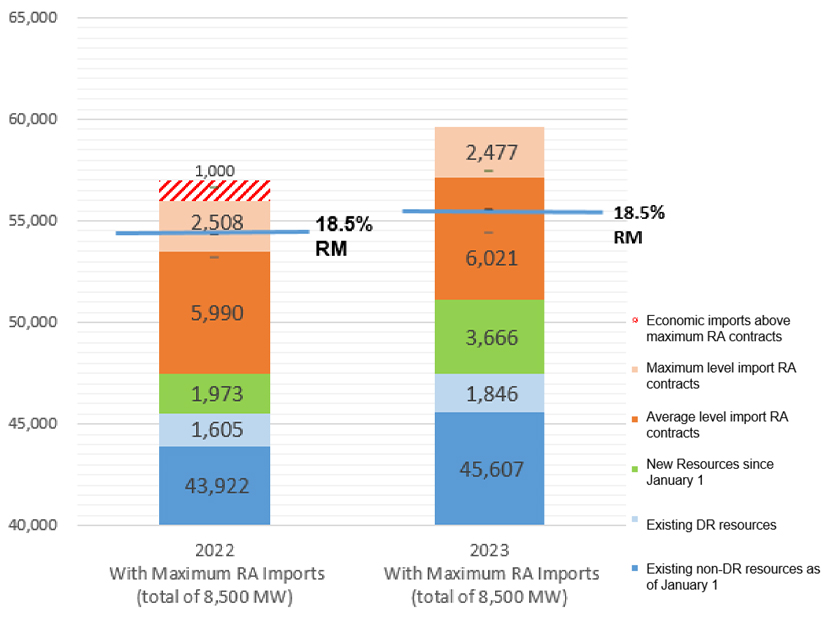
CAISO’s summer forecast looks better than last year’s thanks to the addition of thousands of megawatts of new resources and California’s record snowpack, which is expected to increase hydroelectric generation by 72% compared with drought conditions a year ago.
In its annual Summer Loads and Resources Assessment, published Tuesday, the ISO says it has made “sound progress towards meeting the conventional ‘one day every 10 years’ loss-of-load expectation planning target.”
“Under current high hydro conditions, the resource fleet scheduled to be online by June 1, 2023, exceeds the one-in-10 planning target with a margin of approximately 200 MW … [and with] the resource fleet scheduled to be online by Sept. 1, 2023, exceeds the one-in-10 planning target with a margin of approximately 2,300 MW,” the assessment says.
That compares with a 1,700-MW shortfall in meeting the planning target last year, CAISO management says in a slide presentation on the assessment.
“These results do not take into account more extreme events such as those demonstrated in the last several years, e.g., extreme drought, wildfires and the continued potential for widespread regional heating events and other disruptions that continue to pose a high risk of outages to the ISO grid,” it says.
California experienced energy emergencies caused by extreme heat and wildfires in the past three summers, when the state and much of the West endured worsening drought and decreased hydropower.
The ISO was forced to call for rolling outages in August 2020 during a Western heat wave that dried up imports. It declared an energy emergency in July 2021 when an out-of-control wildfire in Southern Oregon nearly shut down a major transmission pathway between California and the Pacific Northwest.
And it came within minutes of ordering blackouts during a record-setting heat wave in September 2022, when demand outpaced supply. (See CAISO Reports on Summer Heat Wave Performance.)
Since last summer, CAISO has been connecting thousands of megawatts of new battery and solar resources.
By June 1, the ISO expects to have connected 2,500 MW of solar and 2,300 MW of batteries since Sept. 1, 2022. By September of this year, it expects to add another 1,300 MW of solar and 2,000 MW of batteries, bringing the totals to 3,800 MW of solar and 4,300 MW of batteries and (8,100 MW total) added since September 2022, CAISO says in its slide presentation.
In addition, a series of atmospheric rivers this winter filled the state’s hydroelectric reservoirs and pushed the snow water content to approximately 240% of average on April 1, a key date for California’s measurement of snowpack in the Sierra Nevada. The snow melted slowly in April thanks to cloud cover and below-normal temperatures, the state Department of Water Resources said. (May, however, has been hotter than normal, including in the Sierra.)
“The year-to-date snow water content totals are significantly above average, which should result in above-average hydro energy generation in 2023,” the ISO’s summer assessment says.
The assessment does not include a projection of the amount of hydropower that could be generated, but it notes that the state has large and small hydroelectric facilities with more than 7,900 MW of installed capacity.
In the unusually wet winter of 2016/17, large and small hydro generated more than 43,000 GWh of hydroelectric power, compared with about 14,500 GWh in the drought of 2021, a 66% decrease, California Energy Commission records show.
On May 10, the U.S. Energy Information Administration forecast a 72% increase in hydropower generation in California this year compared to 2022.
“One source of uncertainty in our forecast is the possibility of warmer spring temperatures, which would melt the Sierra Nevada snowpack earlier than expected,” the EIA said. “In this case some of the melting snow may bypass power generating turbines for flood control purposes.
“Less snowpack also means less water available to supply hydropower plants during summer months, when electricity generation has historically been at its highest.”
CAISO management plan to present their findings to the Board of Governors at its meeting Thursday.


